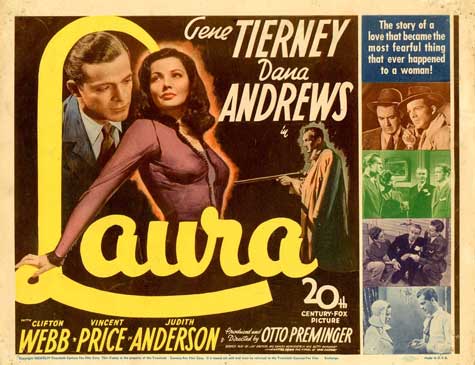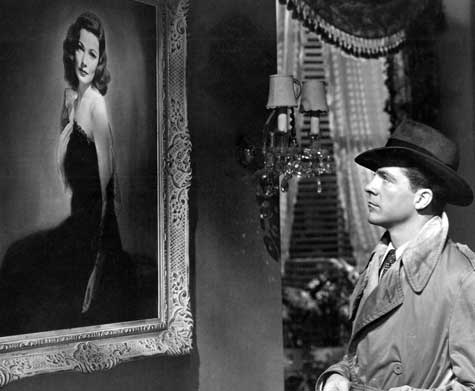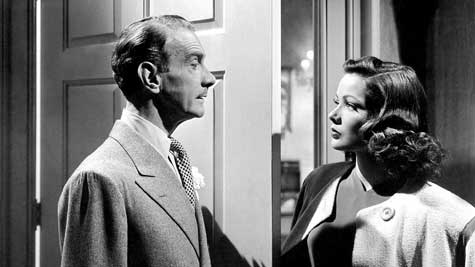
To celebrate the 70th anniversary of film noir’s landmark year, we’re looking at the six key films of 1944: Double Indemnity, Laura, Murder My Sweet, Phantom Lady, When Strangers Marry, and The Woman In the Window. The first film we looked at Billy Wilder’s adaptation of James M. Cain’s Double Indemnity. Today we look at Otto Preminger’s film of Vera Caspary’s Laura.
Laura is among the best known of all noirs. I’m not exactly sure why that is, though I suspect it has something to do with this intriguing premise: a cop investigating the murder of a beautiful young socialite named Laura Hunt finds himself falling in love with the dead woman. I’ll try not to say too much more than that about the plot since this is a mystery and the basic set-up seems to be enough for most people at the outset. What is intriguing about this synopsis, however, is that it actually leaves out the main character.

The main character is neither the murdered Laura (Gene Tierney) nor the cop Mark McPherson (Dana Andrews) who finds himself falling in love with the portrait of her that hangs over her fireplace. No, the main character of the film is Laura’s friend and mentor, Waldo Lydecker, played with acid charm by Clifton Webb. He’s a newspaper columnist who observes the murder investigation with absolute contempt for everyone involved. It’s Lydecker’s withering scorn and urbane sophistication which make Laura something of an anomaly in noir. These kinds of movies aren’t usually narrated by people who could blend into the cocktail party scene in All About Eve. Lydecker sort of classes everything up. Credit should go to screenwriters Jay Dratler, Samuel Hoffenstein, and Betty Reinhardt, working closely from Vera Caspary’s novel. Lydecker never has a boring line of dialogue, and Clifton Webb makes the most of his opportunity here. He was primarily a stage actor when he made this film, but it launched his career in Hollywood. He played smug sophisticates—either dramatically or comically—for the rest of his time in movies.
Good as he is here, Webb isn’t the whole show. Director Otto Preminger has an impressive cast on hand to play the assorted social climbers and millionaires who comprise the cop’s list of suspects. A young Vincent Price is excellent as the scion of a washed-up Southern aristocracy who lives off his ability to charm wealthy women like Laura. Judith Anderson plays another of Price’s benefactors, a rich widow who might have been willing to get Laura out of the way in the race for Price’s affections. Anderson was often cast as frigid she-monsters, but her performance here is surprisingly sympathetic. She’s probably the most honest person in the movie.

Against this colorful cast of uptown characters, Dana Andrews provides a solid foundation as the cop McPherson. He’s something of an enigma himself. Among this group of talkers, McPherson is quiet, watchful, and suspicious of everyone. Andrews was ideal for the role because his specialty was a certain mournful intelligence. (He would use this quality in other excellent noirs like Where The Sidewalk Ends and Fallen Angel.) His thoughts seemed to trouble him, and this is the right quality for McPherson, who never expresses what he’s really thinking. I’ve always felt that the plot transitions into his obsession with Laura a little too quickly—it just seems to happen out of the blue one night—but this isn’t the fault of Andrews. There seems to be a scene missing, one which would bridge the investigation and the obsession.
The key to this missing element is found in the source novel Laura, written by the brilliant novelist/playwright/screenwriter Vera Caspary. (The story had a circuitous route the screen. Caspary had originally conceived the idea as the basis of a screenplay but after being laid off by Paramount Studios, she turned it into a book. Preminger read it and immediately seized on it as great material for a movie. Needing the money, Caspary sold the rights to book to 20th Century Fox for a pittance and then watched as the movie became a sensation.) In the novel, the point of view floats between characters, so while we get Lydecker narrating the beginning, we get McPherson’s obsession from the inside. Preminger and his screenwriters kept much of Caspary’s novel, but they jettisoned the multiple points of view, which creates a bit of narrative confusion as the movie progresses.
Still, perhaps it all works because Gene Tierney was the perfect actress to play the enigmatic Laura Hunt. It wasn’t simply that she was beautiful, it’s that she had a peculiar passivity which seemed to draw people nearer to her. No director knew this better than Preminger, and he utilized this aspect of her personality in several films (including Whirlpool and Where The Sidewalk Ends) but found its richest expression available in Laura. Everyone in the film projects their hopes, fears and obsessions onto her because her beauty is as ethereally empty as a movie screen. The following year Tierney would plumb those empty depths with a harrowing performance in Leave Her To Heaven, but here Preminger uses her emptiness as a vacuum which the other characters fill with their hopes and fears and desires. Only after the film has delivered up its secrets and revealed its mysteries do you realize that its true subject is the way Laura Hunt is a convenient catalyst for the obsessions of everyone around her. Laura is one of the few classic mysteries where the solution actually has resonance, where it reconfigures the meaning of what you’ve seen before.
Jake Hinkson, The Night Editor, is the author of The Posthumous Man and Saint Homicide.
Read all posts by Jake Hinkson for Criminal Element.

PS: I should note that the theme song to Laura was a smash hit. A year after the film came out, Johnnie Mercer wrote lyrics to the music by David Raksin. The song “Laura” was an immediate sensation and quickly became a standard.
Thanks for the write up, Jake. The premise of the cop falling in love with dead Laura intrigued me and I watched it this weekend with much enjoyment. It’s available for streaming on Amazon Prime, for anyone interested.
Thanks for the fine post. Laura is my favorite noir.
Great critique, Jake.
(As the no longer young may know…) David Raksin’s The Bad and the Beautiful is another complex yet accessible theme, for another great Noir.
Watched Laura again because of your post, Vincent Price’s character is slightly dismissive of the theme, saying it’s ‘sweet’…
Love Carly Simon’s coupling of ‘Haunting’ and ‘Laura’.